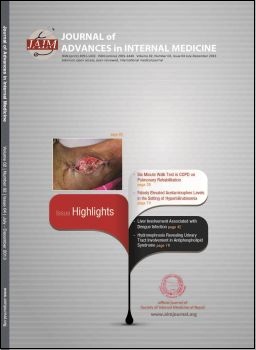Prevalence of Helicobacter pylori infection, its correlation with gastroduodenal diseases and the incidence of gastric cancer in Nepal
DOI:
https://doi.org/10.3126/jaim.v2i2.8777Keywords:
Prevalence, H. pylori, incidence, gastric cancer, NepalAbstract
Background and aims: The Helicobacter pylori (H. pylori) prevalence in Asian countries is highly variable, with higher seroprevalence shown in the previous studies of developing Asian countries. We aimed to determine the current H. pylori prevalence, correlate with gastroduodenal diseases and study gastric cancer incidence in Nepal.
Methods: Among 3357 patients referred for endoscopy, 2820 eligible patients underwent upper gastrointestinal endoscopy with biopsy; H. pylori was considered positive when either of Rapid Urease Test (RUT) or histopathology showed positive result.
Results: The H. pylori prevalence was 29.4% in overall distribution, 41.1% in gastritis and or duodenitis, 69.5% in gastric ulcer, 84.7% in duodenal ulcer, 20.8% in gastric polyp and 11.5% in gastric cancer. The H. pylori infection was significantly associated with gastritis and or duodenitis [P<0.001; Odds Ratio (OR) 1.53, 95% Confidence Interval (CI) 1.47-1.59], gastric ulcer (P<0.001; OR 18.62, 95% CI 12.40-27.81), duodenal ulcer (P<0.001; OR 48.89, 95% CI 25.23- 94.75), gastric polyp (P=0.001; OR 7.66, 95% CI 3.18-18.44) and gastric cancer (P=0.005; OR 3.78, 95% CI 1.82-7.86). The age-standardized (world) annual rate of gastric cancer in Kaski district of Nepal was 3.3 per 100,000.
Conclusions: The H. pylori prevalence in Nepal was lower than that shown in the previous studies of developing Asian countries, but was significantly high in gastritis and or duodenitis, and peptic ulcers. Similarly, the gastric cancer incidence was also low in Nepal and was significantly associated with H. pylori. Further study is needed to establish the association of H. pylori with gastric cancer in Nepal.
DOI: http://dx.doi.org/10.3126/jaim.v2i2.8777
Journal of Advances in Internal Medicine 2013;02(02):52-60
Downloads
Downloads
Published
How to Cite
Issue
Section
License
This license enables reusers to distribute, remix, adapt, and build upon the material in any medium or format, so long as attribution is given to the creator.




